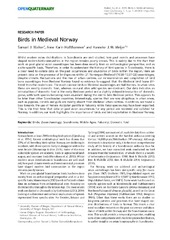| dc.contributor.author | Walker, Samuel James | |
| dc.contributor.author | Hufthammer, Anne Karin | |
| dc.contributor.author | Meijer, Hanneke | |
| dc.date.accessioned | 2020-03-27T09:50:08Z | |
| dc.date.available | 2020-03-27T09:50:08Z | |
| dc.date.issued | 2019 | |
| dc.Published | Walker SJ, Hufthammer AK, Meijer H.J.M. Birds in medieval Norway. Open Quaternary. 2019;5(1):5 | eng |
| dc.identifier.issn | 2055-298X | |
| dc.identifier.uri | https://hdl.handle.net/1956/21602 | |
| dc.description.abstract | Whilst modern avian distributions in Scandinavia are well studied, how past events and processes have shaped modern bird communities in the region remains poorly known. This is mainly due to the fact that work on post-glacial avian assemblages has been done mostly from an archaeological perspective, and on a site-specific basis. Therefore, in order to understand the history of bird species in Scandinavia, there is a clear need to collate data on the past occurrences and abundance of birds within the region. Here we present data on the presence of bird species within 21 Norwegian Medieval (1030–1537 CE) assemblages. Despite climatic fluctuations and the rise of urban centres, our re-examination and compilation of bird bone assemblages from Medieval Norway found no evidence to suggest that the Medieval bird fauna differed from the modern one. The most common birds in Medieval assemblages are Galliformes. In urban sites these are mostly domestic fowl, whereas on rural sites wild species are dominant. Our data indicates an introduction of domestic fowl in the early Medieval period and a slightly delayed introduction of domestic geese, with both species becoming more abundant during the mid to late Medieval period. This appears to be later than other Scandinavian countries. Interestingly, species that are now ubiquitous in urban areas, such as pigeons, corvids and gulls are mostly absent from Medieval urban centres. In addition, we found a bias towards the use of female Accipiter gentilis in falconry, while Falco species may have been exported. This is the first time that data on past avian occurrences for any period are reviewed and collated for Norway. In addition, our work highlights the importance of birds and bird exploitation in Medieval Norway. | en_US |
| dc.language.iso | eng | eng |
| dc.publisher | Ubiquity Press | eng |
| dc.rights | Attribution CC BY | eng |
| dc.rights.uri | http://creativecommons.org/licenses/by/4.0 | eng |
| dc.title | Birds in medieval Norway | eng |
| dc.type | Peer reviewed | en_US |
| dc.type | Journal article | en_US |
| dc.date.updated | 2020-01-10T12:14:02Z | |
| dc.description.version | publishedVersion | |
| dc.rights.holder | Copyright 2019 The Author(s) | eng |
| dc.identifier.doi | https://doi.org/10.5334/oq.58 | |
| dc.identifier.cristin | 1726133 | |
| dc.source.journal | Open Quaternary | |
| dc.identifier.citation | Open Quaternary. 2019, 5 (1), 5. | |

